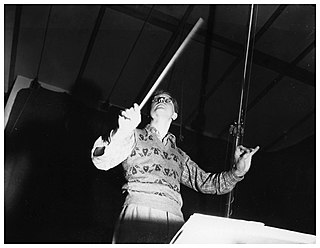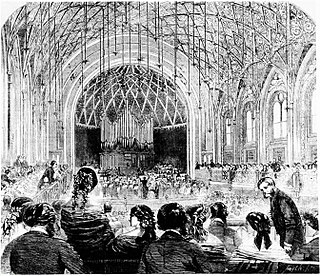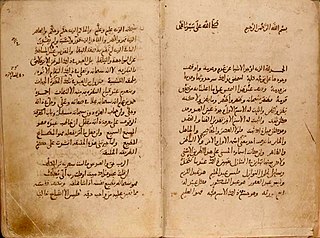Related Research Articles
In musical terminology, tempo also known as Beats per minute, is the speed or pace of a given piece. In classical music, tempo is typically indicated with an instruction at the start of a piece and is usually measured in beats per minute. In modern classical compositions, a "metronome mark" in beats per minute may supplement or replace the normal tempo marking, while in modern genres like electronic dance music, tempo will typically simply be stated in BPM.

The Concerto for Orchestra, Sz. 116, BB 123, is a five-movement orchestral work composed by Béla Bartók in 1943. It is one of his best-known, most popular, and most accessible works.

The Symphony No. 4 in E minor, Op. 98 by Johannes Brahms is the last of his symphonies. Brahms began working on the piece in Mürzzuschlag, then in the Austro-Hungarian Empire, in 1884, just a year after completing his Symphony No. 3. Brahms conducted the Court Orchestra in Meiningen, Germany, for the work's premiere on 25 October 1885.

The Symphony No. 4 in B♭ major, Op. 60, is the fourth-published symphony by Ludwig van Beethoven. It was composed in 1806 and premiered in March 1807 at a private concert in Vienna at the town house of Prince Lobkowitz. The first public performance was at the Burgtheater in Vienna in April 1808.

Douglas Gordon Lilburn was a New Zealand composer.

The Symphony No. 1 in F minor, Op. 10, by Dmitri Shostakovich was written in 1924–1925, and first performed in Leningrad by the Leningrad Philharmonic under Nicolai Malko on 12 May 1926. Shostakovich wrote the work as his graduation piece at the Petrograd Conservatory, completing it at the age of 19.

Edward Elgar's Cello Concerto in E minor, Op. 85, his last notable work, is a cornerstone of the solo cello repertoire. Elgar composed it in the aftermath of the First World War, when his music had already gone out of fashion with the concert-going public. In contrast with Elgar's earlier Violin Concerto, which is lyrical and passionate, the Cello Concerto is for the most part contemplative and elegiac.
Symphony No. 6 "Sinfonia semplice",, FS 116. In August 1924 Danish composer Carl Nielsen began working on a Sixth Symphony, which turned out to be his last. By the end of October he wrote to Carl Johan Michaelsen:
As far as I can see, it will on the whole be different from my other symphonies: more amiable and smooth, or how shall I put it, but it is impossible to tell as I do not know at all what currents I may run into during the voyage.

The Symphony No. 3 in C minor, Op. 78, was completed by Camille Saint-Saëns in 1886 at the peak of his artistic career. It is popularly known as the Organ Symphony, since, unusually for a late-Romantic symphony, two of the four sections use the pipe organ. The composer inscribed it as: Symphonie No. 3 "avec orgue".

Sir Edward Elgar's Introduction and Allegro for Strings, Op. 47, was composed in 1905 for performance in an all-Elgar concert by the newly formed London Symphony Orchestra. Scored for string quartet and string orchestra, Elgar composed it to show off the players' virtuosity. Though initial critical reception was lukewarm at best, the score soon came to be recognized as a masterpiece. The work, which is roughly twelve to fourteen minutes in length, is like a multi-layered symphonic poem for string orchestra, with several prominent themes.

The Symphony No. 5 in E-flat major, Op. 82, is a three-movement work for orchestra written from 1914 to 1915 by the Finnish composer Jean Sibelius. He revised it in 1916 and again from 1917 to 1919, at which point it reached its final form.
The Symphony No. 1 of Douglas Lilburn was completed in 1949, and had its premiere in 1951. The symphony is in three integrated movements; a typical performance lasts around 30 minutes.
The Symphony No. 3 of Douglas Lilburn was completed in 1961, in response to a sabbatical from Victoria University of Wellington. It was given its premiere the following year, and published by Faber Music around 1968.
The Symphony No. 1 in C minor, B. 9, subtitled The Bells of Zlonice, was composed by Antonín Dvořák during February and March 1865. It is written in the early Romantic style, inspired by the works of Ludwig van Beethoven and Felix Mendelssohn. Dvořák never heard or revised the symphony, because the completed work was lost during his lifetime. It premiered in 1936.
The Symphony No. 6 in E-flat minor, Op. 23 by Nikolai Myaskovsky was composed between 1921 and 1923. It is the largest and most ambitious of his 27 symphonies, and uses a chorus in the finale. It has been described as "probably the most significant Russian symphony between Tchaikovsky's Pathétique and the Fourth Symphony of Shostakovich". The premiere took place at the Bolshoi Theatre, Moscow on 4 May 1924, conducted by Nikolai Golovanov and was a notable success.
Symphony No. 2 in E minor was written by Wilhelm Furtwängler between 1945 and 1946 in Switzerland. It is in four movements:
- Assai moderato - Allmählich belebend - Von hier ab festes Tempo (Allegro)
- Andante semplice (Tranquillo)
- Un poco moderato - Più Allegro - Più Moderato - Allegro - Moderato - Allegro
- Langsam - Moderato andante - Allegro molto - Moderato - Langsam - Moderato - Presto
William Walton's Cello Concerto (1957) is the third and last of the composer's concertos for string instruments, following his Viola Concerto (1929) and Violin Concerto (1939). It was written between February and October 1956, commissioned by and dedicated to the cellist Gregor Piatigorsky, the soloist at the premiere in Boston on 25 January 1957.
Introduction and Allegro for Harp, Flute, Clarinet and String Quartet is a chamber work by Maurice Ravel. It is a short piece, typically lasting between ten and eleven minutes in performance. It was commissioned in 1905 by the Érard harp manufacturers to showcase their instruments, and has been described as a miniature harp concerto. The premiere was in Paris on 22 February 1907.

An autograph or holograph is a manuscript or document written in its author's or composer's hand. The meaning of autograph as a document penned entirely by the author of its content, as opposed to a typeset document or one written by a copyist or scribe other than the author, overlaps with that of holograph.
References
- ↑ See: OCLC 154285031
- ↑ metronome markings are from the 1979 score.
- ↑ See: OCLC 8319388 (e.g. University of Missouri Kansas City, other locations. Typeset miniature score, 116 pages.)
- ↑ This makes sense as there were several earlier recordings. A holograph of the 1974 revision is at Victoria University of Wellington (see OCLC link), for instance. (According to library and Worldcat, holograph score- 136 pages.)
- Douglas Lilburn. The Three Symphonies. New Zealand Symphony Orchestra, James Judd, rec. 2001 on Naxos Records